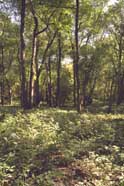
 |
Floodplain
forests occur along streams and rivers in Illinois. These forests range
from relatively well drained (mesic), to poorly drained (wet), and are
flooded for varying periods of time each year. The most common floodplain
forest type in Illinois is the wet-mesic floodplain forest.
Characteristic trees are silver maple, elm, and ash, with no clearly dominant tree type. It is wet for a significant portion of the year, but the surface is, in fact, dry for much of the year. Flooding usually occurs in the spring, but can occur into the early summer months. |
What
conditions make it hard for trees to grow in floodplain forests?
Floodplains
are extremely challenging environments for plants. Trees and shrubs must
be able to withstand being partially covered by water and water-deposited
sand and other sediments. There is a high degree of seasonal disturbance
within these ecosystems. The floodplain is shaped and reshaped by the meandering
(shifting of stream course from side to side) of streams and rivers. During
flooding events, soils are disturbed and/or washed away and new sediments
are deposited. The kinds and amounts of sediments deposited depend on the
size and duration of the flood.
Intense floods are capable of carrying large flotsam (debris) and ice, which can damage trees. Floods deposit larger-sized particles like sand and pebbles. Silts and clays are deposited in slower moving or still water. Usually there are alternating layers of sand, silt, and fine mud deposited during a flooding season, depending on the duration and course of flooding.
Sand bar willow (Salix interior) is an example of a tree/shrub that is able to withstand being partially buried by sand and continue to grow.
Soil moisture in floodplain forest
Soil
moisture fluctuates dramatically throughout the year. Soils that are waterlogged
in the spring can be dry in the late summer. Portions of a floodplain closest
to the stream or river can remain submerged during periods from one week
to as long as two months.
Under these conditions, oxygen deficiency in the soil is the first and most significant problem faced by floodplain vegetation. Roots cannot work well in soil with low oxygen levels. Without any oxygen whatsoever, the tips of the roots, where mineral nutrients and water are absorbed, die within hours.
The symptoms of root damage resulting from lack of oxygen in the soil appear in the shoots and leaves. Shoots wilt, leaves curl and become yellow (chlorotic), and growth stops because normal physiological processes have been slowed down or halted. Damaging byproducts accumulate in the plants. Ethylene, for example, a chemical that is associated with aging in plants, accumulates in the shoots under such circumstances, and results in damages plant tissues.
Under waterlogged conditions iron and manganese occur in reduced forms (without oxygen) that can be absorbed by the roots. Iron and manganese are essential plant nutrients, but become toxic if they accumulate to high levels in plant tissues.
How
do plants adapt to floodplain conditions?
Floodplain
plants have a variety of adaptive strategies to cope with the seasonal
flooding.
- Some of the trees restrict roots to the upper layers of soil, which will be better aerated (contain more oxygen). Willow (Salix species), for example responds to rising water tables with a rapid growth of roots that spread out horizontally. They let the plant take up more oxygen. They also stabilize the plant in shifting or changing sediments and soils.
- Many of the woody plants in the floodplain have well-developed lenticels (small holes in the bark), in addition to stomata in leaves. Oxygen from the atmosphere can be transported to the roots through these lenticels. Both willow and green ash have some ability to transport oxygen through the lenticels and down to the roots.
- Some plants, such as alder (Alnus species), possess special metabolic pathways that prevent the combination of damaging effects that result from the lack of oxygen.
- Others, such as black gum (Nyssa sylvatica) and ash (Fraxinus pennsylvanica) develop oxidized root zones. Development of an oxygen-filled zone around the roots helps prevent the excess absorption of iron and manganese.
|
|
Copyright © 2000 Illinois State Museum